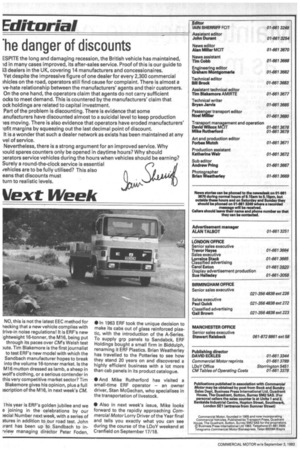Editorial he danger of discounts
Page 4

If you've noticed an error in this article please click here to report it so we can fix it.
ESPITE the long and damaging recession, the British vehicle has maintained, Id in many cases improved, its after-sales service. Proof of this is our guide to 13 dealers in the UK, covering 14 manufacturers and concessionaires.
Yet despite the impressive figure of one dealer for every 2,300 commercial ;hides on the road, operators still find cause for complaint. There is almost a ve-hate relationship between the manufacturers' agents and their customers. On the one hand, the operators claim that agents do not carry sufficient ocks to meet demand. This is countered by the manufacturers' claim that ock holdings are related to capital investment.
Part of the problem is discounting. There is evidence that some anufacturers have discounted almost to a suicidal level to keep production les moving. There is also evidence that operators have eroded manufacturers' .ofit margins by squeezing out the last decimal point of discount.
It is a wonder that such a dealer network as exists has been maintained at any vel of service.
Nevertheless, there is a strong argument for an improved service. Why iould spares counters only be opened in daytime hours? Why should 3erators service vehicles during the hours when vehicles should be earning? Surely a round-the-clock service is essential rehicles are to be fully utilised? This also eans that discounts must turn to realistic levels.
























































































































